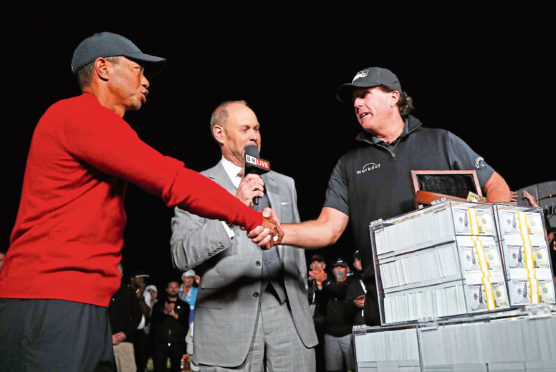Reports from the USA had it that Turner Broadcasting Systems, who bankrolled the hyped “The Match” between Tiger Woods and Phil Mickelson needed 500,000 pay-per-view subscribers to break even.
They’d guaranteed the two main protagonists their shares of the $9 million at stake (an aside: apparently the purse was held at that figure by the dictat of PGA Tour commissioner Jay Monahan, who insisted it had to be lower than the $10 million FedEx Cup winnings if the tour was going to sanction the thing).
So the collapse of the PPV system (didn’t they even ask someone from boxing how it worked?) on the night means that everyone is going to get their $20 back, and TBS has to cover it all.
TBS is not the biggest of the US networks, but it can still take the hit. But it was a timely retort to the naked greed at work in this whole sorry episode.
It’s amazing what a mere photograph can do. Like many, I had no real interest in the event but no particular hostility to it until the photographs of Woods and Mickelson with a pile of cash a couple of days before the event.
I mean. What. The. Actual. pic.twitter.com/E1t3R0FeDu
— Georgie Bingham (@georgiebingham) November 21, 2018
Mickelson was attempting a rather embarrassing “mo’ money” gesture at what he, a man of nearly 50, approximates as being down with the kids, I suppose. He looked like an idiot.
Woods at least had the gall to look a little embarrassed in his “cash” picture. But while in the vast majority of his workings within golf (outside of the game is a different matter) Tiger has conducted himself with a significant degree of class; this was utterly classless.
The product itself didn’t deliver on the hype, but it was never going to. A bounce game between two people who didn’t really seem to have much interesting to say to each other – they seemed like Facebook friends rather than real ones – with a bunch of side-wagers designed to take advantage of America’s sudden discovery of sports betting that didn’t add any frisson of excitement whatsoever.
I liked golf.com’s Alan Shipnuck’s verdict of them being mic’d up – Phil’s heavy breathing and Tiger apparent sniffles from a cold were incredibly distracting, even if you were slightly interested in their bland small talk.
If the pair were trying to turn this into a future franchise, there’s work to do. First of all, try and get a course that isn’t a couple of weeks into its winter maintenance programme. Speak to someone in boxing about how to do a proper showdown and how PPV works.
Under no circumstances end it with 90-yard pitch shots to the putting green. Up to that point I didn’t think the whole enterprise could be diminished further; I was wrong.
They simply have to give more money from this concept to charity; even golf charities. At least make a significant gesture to growing the game (see below).
And add some more interesting characters. The most entertaining element of the whole thing (I watched the US feed) was the former basketballer and famously inept social golfer Charles Barkley doing occasional commentary.
Barkley even had the guts to do what no golf commentator (even Johnny Miller) would dream of doing; vocally calling out the two superstars for playing rubbish golf.
Which, bottom line, is what it all was.
Eddie makes the point
The thoughtful Eddie Pepperell was one of the few leading golfers to come out wholly against The Match, describing as “putrid, puerile and pathetic”.
Eddie got the usual responses on Twitter, accusing him of jealousy and stating that without Woods and Mickelson, there wouldn’t be the millions he plays for week to week.
This is where I holidayed this week… Think that rules jealousy out. pic.twitter.com/vIXoWZV21Y
— Eddie Pepperell (@PepperellEddie) November 25, 2018
This is the narrative given by some that Tiger Woods (and Phil, to a lesser extent) are responsible in entirety for golf’s modern prizefunds and even the general popularity of the sport.
But as Eddie went on to explain in his blog this simply doesn’t add up to serious scrutiny. It’s something I’ve mentioned from time to time in T2G as well.
The first thing to point out is that golf in its traditional strongholds of the US and the UK has been losing participation right throughout the era of Tiger and Phil. If their mere presence were so great at growing the game, why does this slump continue to happen?
The prizefunds are a more nuanced issue, but it’s generally assumed that Tiger and Tiger alone is responsible for the huge leap in prizemoney on the PGA Tour and elsewhere. Tiger’s career and the leap in money have coincided, so it’s an easy assumption to make.
However, as Eddie points out, every major world sport enjoyed this stratospheric rise in money, and not all of them had a Tiger. The real trend was TV money, and it came from broadcasters identifying who was watching and how best to get their cash through subscriptions and advertising.
Tiger’s career hasn’t hurt golf’s earning power, obviously, but the real factor was TV networks willing to pay vast amounts to access golf’s audience, which disproportionately consists of high-earners, mostly males.
The boom would have happened without Tiger. Has he really grown the game? Yes, but only marginally.
